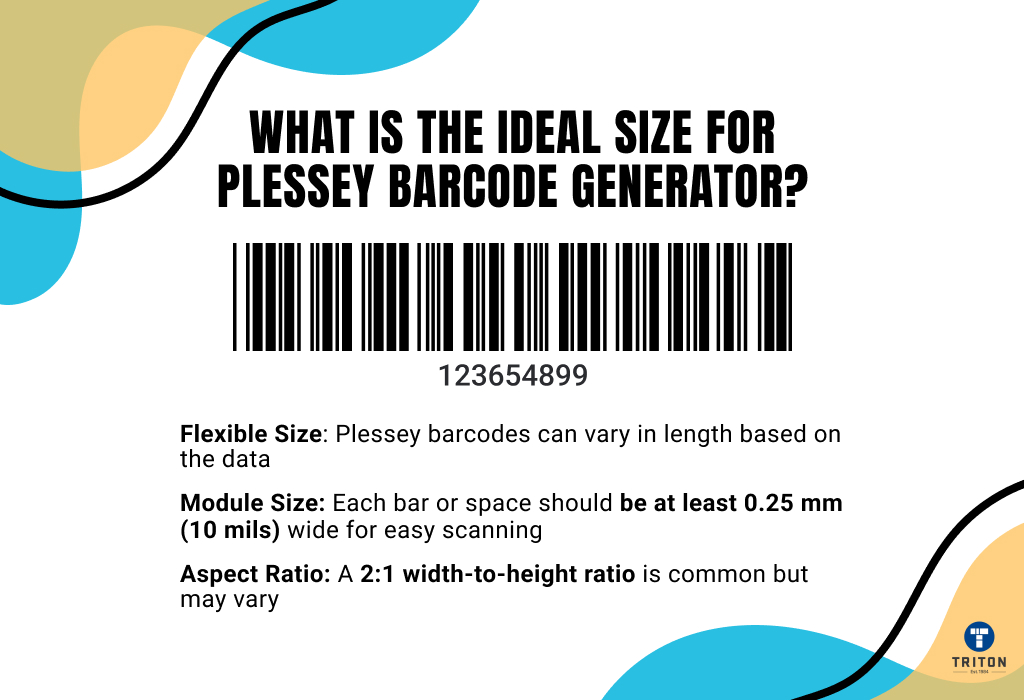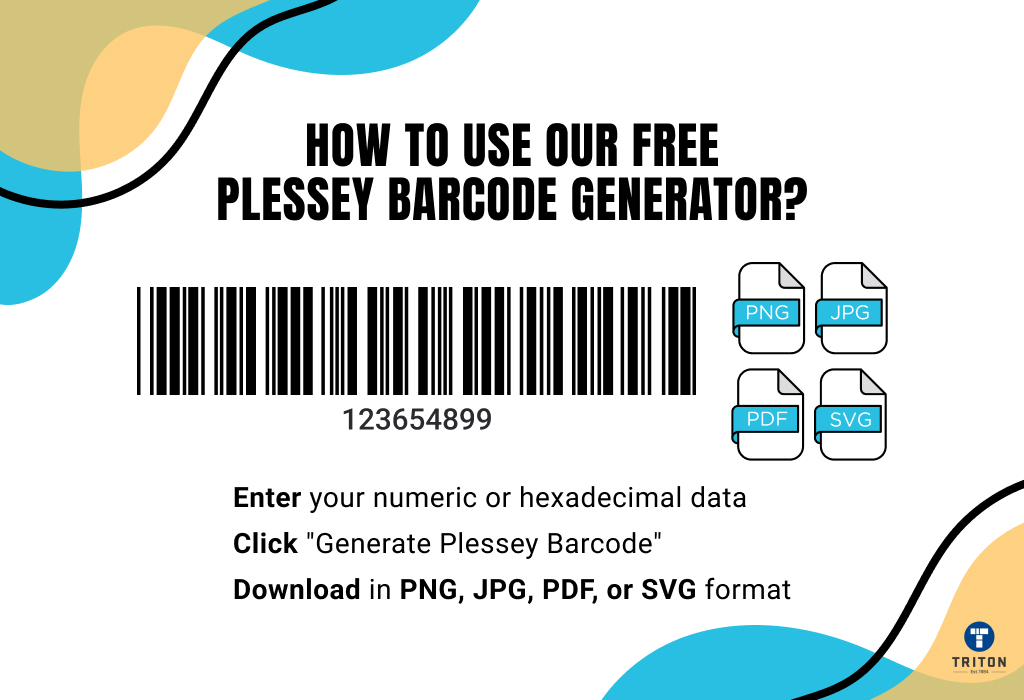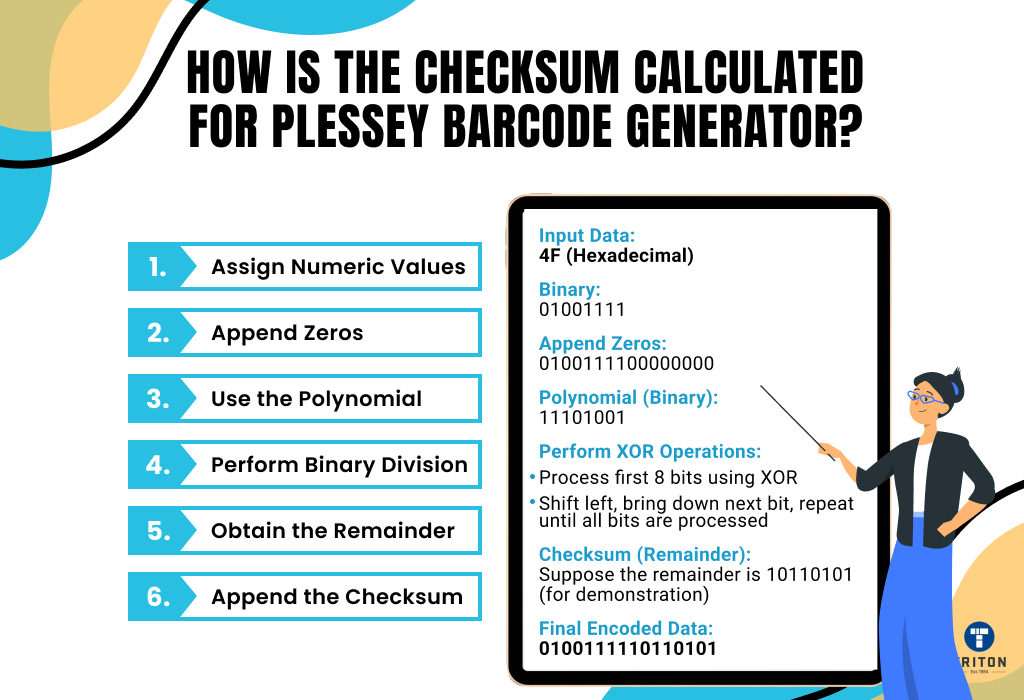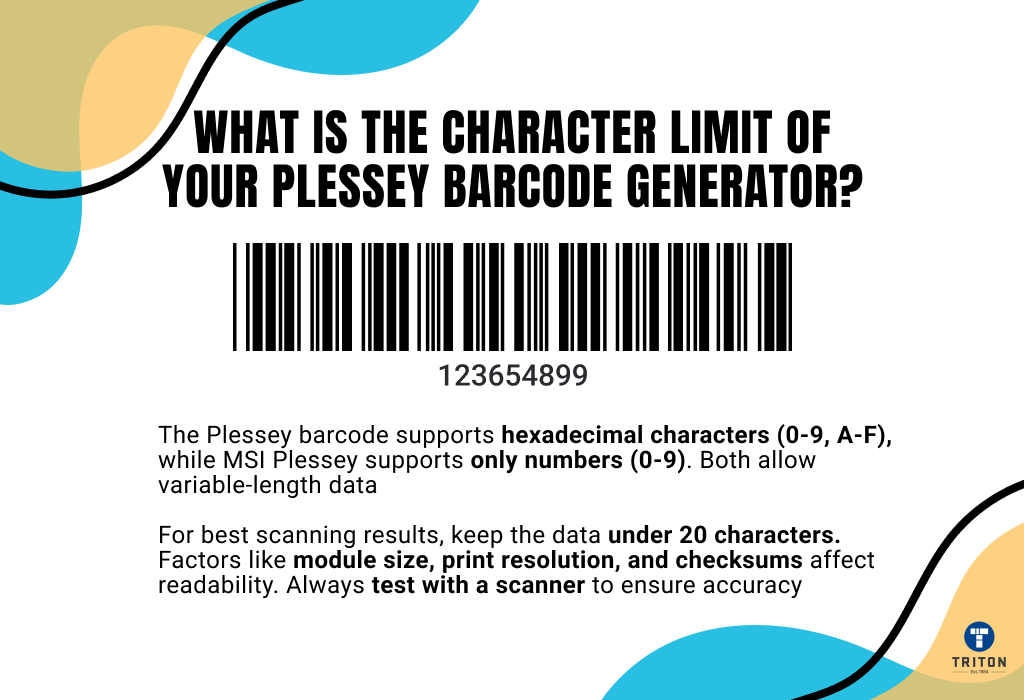
Our Plessey Barcode Generator enables you to create compact, reliable barcodes designed for applications such as inventory management, warehouse tracking, and some library systems. You can generate barcodes effortlessly, customise dimensions, and download them in formats like PNG, SVG, or PDF. The generator offers compatibility with standard barcode scanners and flexible integration options to streamline your operations.

The ideal size of a Plessey barcode depends on the amount of data encoded, the scanning environment, and available space. Plessey barcodes are variable-length symbologies, allowing flexibility in their dimensions. For optimal readability:
Key Considerations for Optimal Sizing:
Module Size: Each module (the smallest bar or space) should be at least 0.25 mm (10 mils) wide to ensure reliable scanning.
Aspect Ratio: Maintain a width-to-height ratio that supports easy scannability. A ratio of 2:1 is common, but it may vary based on your specific application.
Testing: Always test barcodes under real-world conditions using the intended scanners to verify readability.
Print quality, contrast, and proper quiet zones are critical to ensure the barcode’s readability. Use high-resolution printing and consider placement to avoid distortions.

Creating a Plessey barcode with our free generator is straightforward:
Enter the numeric or hexadecimal data you want to encode.
Click “Generate Plessey Barcode.”
Download the barcode in your preferred format—PNG, JPG, PDF, or SVG.
Whether for inventory tracking, warehouse management, or library systems, our generator ensures accurate, high-quality outputs ready for seamless integration.

Checksum calculation for Plessey barcodes ensures data integrity and follows a Cyclic Redundancy Check (CRC) algorithm. Here’s a step-by-step process:
Prepare the Data:
Convert the hexadecimal data (0-9, A-F) to its binary representation. Each hexadecimal digit corresponds to a 4-bit binary sequence.
Append Zeros:
Add 8 zeros to the end of the binary data to prepare for the CRC calculation.
Select the Polynomial:
Use the standard Plessey polynomial: x^8 + x^7 + x^6 + x^5 + x^3 + 1 (binary representation: 11101001).
Perform Binary Division:
Divide the binary data (with the appended zeros) by the polynomial using binary division (XOR operation).
Obtain the Remainder:
The remainder from this division is the checksum. It will be an 8-bit binary sequence.
Append the Checksum:
Add the checksum to the end of the original binary data. This forms the complete Plessey barcode.
Let’s walk through an example to understand this better.
Input Data: 4F (hexadecimal)
Binary Representation: 01001111
Append Zeros: 0100111100000000
Polynomial (Binary): 11101001
Step-by-Step Calculation:
Perform XOR Operations:
Compare the first 8 bits of data with the polynomial and perform the XOR operation.
Shift the result left and bring down the next bit.
Repeat the XOR process until all bits are processed.
Remainder (Checksum): Suppose the remainder is 10110101 (for demonstration purposes).
Final Result:
The final encoded data is 0100111110110101.
This process ensures the barcode’s data is accurate and reliable for scanning across various systems.
If you are unfamiliar with CRC or polynomial division, barcode software or online tools can automatically handle checksum generation based on the standard Plessey polynomial.

The original Plessey Code encodes hexadecimal characters (0-9 and A-F), while MSI Plessey encodes numeric data only. Both are variable-length symbologies, allowing flexibility based on the data and space available for printing.
Practical Usage:
To maintain scannability and error detection, it’s recommended to keep the data under 20 characters for most applications.
Factors such as module size, print resolution, and inclusion of checksums affect the barcode’s data capacity.
Always test your barcode with scanning equipment to ensure it meets operational requirements.
Plessey barcodes, developed in the early 1970s by The Plessey Company in the UK, have found use in several niche applications due to their compact design and reliable encoding. While they are not as widely used as other barcode symbologies, they remain valuable in specific industries.
Common Applications of Plessey Barcodes:
Library Systems:
Plessey barcodes are frequently used in library systems for tracking books and other materials. Their compact format and ability to encode numeric and hexadecimal data make them suitable for cataloging and circulation systems.
Warehouse and Inventory Management:
In some industries, Plessey barcodes are used for tracking inventory and managing warehouse stock. Their ability to handle large amounts of data in a small space makes them ideal for shelf labels and storage bin identification.
Retail Shelf Labeling:
Some retail environments use Plessey barcodes for shelf labeling and price tagging, especially in situations where compact, durable labels are needed.
Electronics Industry:
Plessey barcodes have been used in the electronics sector for labeling components and circuit boards due to their small size and reliable scanning capabilities.
Library Management in the UK:
Historically, Plessey barcodes were widely adopted in UK library systems, although many have since transitioned to more modern symbologies like Code 39 or QR codes.
While their use has declined in favour of more versatile barcode formats, Plessey barcodes remain a reliable choice in industries where compact, error-resistant encoding is essential. Their decline is largely due to the adoption of more versatile and globally recognised barcode symbologies like Code 128, QR codes, and Data Matrix, which support more data and advanced error correction.
There is no scan limit for Plessey barcodes generated using our online barcode generator. Once created, the barcode can be scanned unlimited times, as long as it is printed or displayed clearly and adheres to quality standards.
The barcode’s durability depends on the medium used for printing and its exposure to wear and tear. Ensuring proper contrast, resolution, and alignment during generation and printing guarantees reliable performance across compatible scanning devices. This makes Plessey barcodes a dependable solution for applications like inventory tracking, retail, and library systems.
Yes, we offer a variety of other barcode generators. In addition to the Plessey barcode, you can generate QR Code, Code 128, Code 39, EAN-13, ITF, Data Matrix, and GS1 DataBar. We also provide tools for specialised barcodes like Aztec Code, Maxicode, and UPC.
All our online barcode generators are free to use, allowing you to customise and download barcode images for various applications, including retail, inventory management, and logistics.
Auckland
Christchurch
Phone 09 579 2057
Live Chat – Widget below
Auckland
Christchurch
Phone 09 579 2057
Live Chat – Widget below